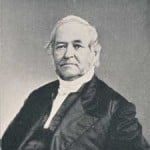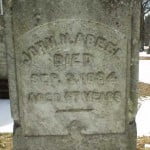“He fought and preached alternately”
John Craighead was the second son of John and Rachel R. Craighead and the grandson of the Rev. Thomas Craighead. His great-grandfather was the Rev. Robert, a Scotsman who immigrated to Ireland around 1657 and served as pastor of churches in donoughmore and Londonderry. Robert later moved to Dublin and is noted for having authored several works on the Christian life. Thomas Craighead, the son of Robert, came to New England in 1715 and preached for about eight years near Fall River, Massachusetts, before moving to Delaware, where he was installed as the pastor of the White Clay Creek church. In 1733, Thomas answered a call to serve the congregation at Pequea, in Lancaster county, Pennsylvania, and his last pulpit was in Hopewell, PA.
John was born in 1742, near Carlisle, Pennsylvania, his parents having relocated from Lancaster in 1742. He graduated from Princeton College in 1763, where he had been a classmate with Robert Cooper, then studied theology with Dr. Robert Smit, of Pequea. John was ordained by the Presbytery of Donegal and installed, on April 13, 1768, as pastor of the Rocky Spring church, near Chambersburg, Pennsylvania. His salary, upon accepting this call, was L100 per year.
Rev. Craighead continued his ministry at the Rocky Spring church until 1789, when, on account of declining health and mental derangement, his pastoral relation was dissolved. Apparently he was prone to fits of deep depression which made ministry difficult, if not impossible. Yet by 1791 he was noted as being in regular attendance at the meetings of the Carlisle Presbytery and was even appointed to serve the Presbytery as its commissioner to General Assembly that year. He served as commissioner to General Assembly again in 1793. Finally on April 9th, 1799, the Presbytery was compelled to dissolve his pastoral relation “solely due to inability,” and his death followed soon after. He died on April 20, 1799, and was buried in the Rocky Spring graveyard.
Mr. Craighead is noted in history for his earnest and patriotic appeals to his people during the struggle for American Independence, and for his services as captain and chaplain to a company formed from his own congregation in response to his patriotic appeals, at a solemn crisis in the war, when the whole male portion of the congregation rose to their feet in token of readiness to embark in defense of the country.
The old church at Rocky Spring was still extant as late as the 1880’s. Though somewhat altered, it retained substantially the original main features. The aisles were paved with brick; the pews were straight-backed and unpainted oak; the pulpit was narrow, with its sounding board painted a light blue; the elders’ bench was a simple thick slab of wood; the communion service was made of pewter, imported from London, but black with age. Two ten-plate stoves, of a very primitive form, were used to warm the building, with their stove pipes ascending through holes cut in the ceiling, where the smoke released into the attic and escaped, without any chimneys, the best way it could. The side door was still there, where Mr. Craighead stood and cajoled the men assembled in the churchyard, and so stirred their patriotic passions that they soon organized themselves into a company and went through the Revolutionary War with their pastor as captain and chaplain.
One biographer of Rev. Craighead wrote that he preached “in glowing terms, Jesus Christ, the only hope of salvation, and after the delivery of his sacred message, in eloquent and patriotic strains exhorted the youth of his congregation to rise up and join the noble band, then engaged under the immortal Washington, in struggling to free our beloved country from British oppression,” and that “On one of these occasions, the patriot preacher declaimed in such fervid and powerful terms respecting the evils his country was enduring, and presented such a description of each man’s duty that ‘the whole congregation rose from their seats and declared their willingness to march to the conflict.’ “
Words to Live By:
Having read that last account, the obvious question by comparison is, What does it take to get a congregation to rise up for the cause of Christ? When so many endeavors so easily obtain our whole attention, what does it take for the Lord Jesus Christ to have first place in our hearts and minds? Or what does it take just simply for the congregation to regularly, faithfully go to their knees in prayer?
Lord, may we be a praying people, intent upon doing Your will, ever watching to see Your hand at work, waiting upon your every provision.
Sources:
Centennial Memorial of the Presbytery of Carlisle, vol. 2, pp. 47-48; Nevin’s Encyclopedia, p. 162.




